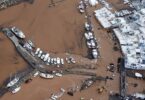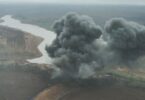A huge rainforest stretching across the heart of Africa is quietly performing a vital role in protecting the planet. Home to endangered species and ancient communities, it covers more land than most people realise. The Congo Basin spans 3.4 million square kilometres, making it almost six times the size of the UK, which measures around 242,000 square kilometres.
It is also Africa’s biggest rainforest and the second-largest in the world after the Amazon. It stretches across six Central African countries – Cameroon, the Central African Republic, the Democratic Republic of Congo, the Republic of Congo, Equatorial Guinea, and Gabon. The forest covers an area of around 300 million hectares and supports an extraordinary variety of life. According to the Rainforest Trust, it is home to rare and endangered animals such as forest elephants, bonobos, gorillas, okapis, and the Congo peacock.
Beyond its biodiversity, the Congo Basin plays an essential role in absorbing carbon dioxide, helping to stabilise global temperatures and slow the effects of climate change.
In October 2023, the region hosted the Three Basins Summit in Brazzaville, bringing together countries from the Congo, Amazon, and Borneo-Mekong rainforests to coordinate conservation efforts.
The importance of the Congo Basin was first recognised at a political level in 1999, when African leaders met in Yaoundé, Cameroon, for the Yaoundé Forest Summit.
This led to cross-border agreements to establish protected areas, create transboundary parks, and safeguard the communities and wildlife that depend on the forest, says WWF.
Despite these efforts, the forest faces growing threats from logging, agriculture, mining, and infrastructure projects.
Some areas are also affected by illegal deforestation, which is often difficult to detect.
To address this, conservationists are turning to new tools. In Gabon, WWF reports that an AI-powered system called Forest Foresight can now predict illegal deforestation up to six months in advance, giving forest managers time to act.
The system is also used in Cameroon, in partnership with the Ministry of Forests and Wildlife.
Other projects across the region include camera monitoring systems to track animals in hard-to-reach parts of the forest, and training for local eco-guards to protect wildlife and ensure that local communities retain access to natural resources.
Some of Africa’s best-known protected areas are found within the Congo Basin.
These include Salonga National Park in the DRC, the Dzanga-Sangha protected zone in the Central African Republic, and Nouabalé-Ndoki National Park in the Republic of Congo.
The Congo Basin forms part of a global trio of tropical rainforests – along with the Amazon and Borneo-Mekong regions – which together account for 80% of the world’s remaining tropical forests and two-thirds of all terrestrial biodiversity, according to WWF.
Scientists and conservationists warn that if the Congo rainforest continues to decline, the consequences will be felt far beyond Africa.
Source link








